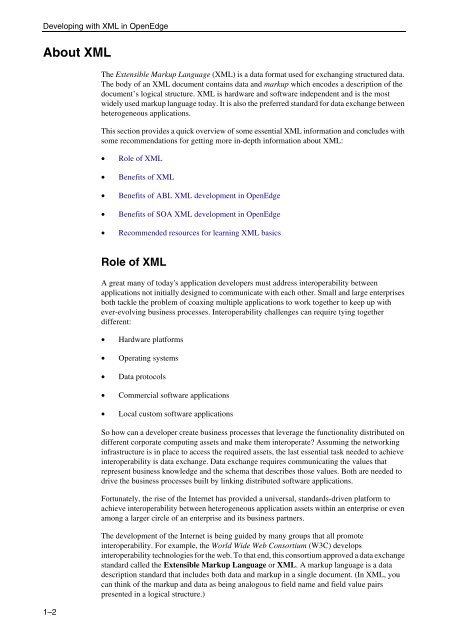OpenEdge Development: Working with XML - Product ...
OpenEdge Development: Working with XML - Product ...
OpenEdge Development: Working with XML - Product ...
You also want an ePaper? Increase the reach of your titles
YUMPU automatically turns print PDFs into web optimized ePapers that Google loves.
Developing <strong>with</strong> <strong>XML</strong> in <strong>OpenEdge</strong><br />
About <strong>XML</strong><br />
1–2<br />
The Extensible Markup Language (<strong>XML</strong>) is a data format used for exchanging structured data.<br />
The body of an <strong>XML</strong> document contains data and markup which encodes a description of the<br />
document’s logical structure. <strong>XML</strong> is hardware and software independent and is the most<br />
widely used markup language today. It is also the preferred standard for data exchange between<br />
heterogeneous applications.<br />
This section provides a quick overview of some essential <strong>XML</strong> information and concludes <strong>with</strong><br />
some recommendations for getting more in-depth information about <strong>XML</strong>:<br />
• Role of <strong>XML</strong><br />
• Benefits of <strong>XML</strong><br />
• Benefits of ABL <strong>XML</strong> development in <strong>OpenEdge</strong><br />
• Benefits of SOA <strong>XML</strong> development in <strong>OpenEdge</strong><br />
• Recommended resources for learning <strong>XML</strong> basics<br />
Role of <strong>XML</strong><br />
A great many of today's application developers must address interoperability between<br />
applications not initially designed to communicate <strong>with</strong> each other. Small and large enterprises<br />
both tackle the problem of coaxing multiple applications to work together to keep up <strong>with</strong><br />
ever-evolving business processes. Interoperability challenges can require tying together<br />
different:<br />
• Hardware platforms<br />
• Operating systems<br />
• Data protocols<br />
• Commercial software applications<br />
• Local custom software applications<br />
So how can a developer create business processes that leverage the functionality distributed on<br />
different corporate computing assets and make them interoperate? Assuming the networking<br />
infrastructure is in place to access the required assets, the last essential task needed to achieve<br />
interoperability is data exchange. Data exchange requires communicating the values that<br />
represent business knowledge and the schema that describes those values. Both are needed to<br />
drive the business processes built by linking distributed software applications.<br />
Fortunately, the rise of the Internet has provided a universal, standards-driven platform to<br />
achieve interoperability between heterogeneous application assets <strong>with</strong>in an enterprise or even<br />
among a larger circle of an enterprise and its business partners.<br />
The development of the Internet is being guided by many groups that all promote<br />
interoperability. For example, the World Wide Web Consortium (W3C) develops<br />
interoperability technologies for the web. To that end, this consortium approved a data exchange<br />
standard called the Extensible Markup Language or <strong>XML</strong>. A markup language is a data<br />
description standard that includes both data and markup in a single document. (In <strong>XML</strong>, you<br />
can think of the markup and data as being analogous to field name and field value pairs<br />
presented in a logical structure.)
















